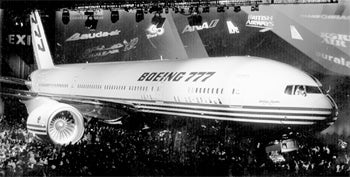 |
| STANDARD DATA: Seats 375-400. Gross wt. 506,000-580,000. Empty wt. 306,492 lbs. Fuel capacity 31,000. Engines two 77,000-lb. s.t. Pratt & Whitney PW4000 turbofans. PERFORMANCE: Top cruise 508 kts. Ceiling 43,000′. Range 4,560-8,490. Takeoff distance 10,600. Landing distance 6,000. |
The 777 was initially imagined to be a variant of the 767, but eventually morphed into a whole new design. It was to become Boeing’s most advanced aircraft, using fly-by-wire technology, a glass flightdeck and composite construction. The 777 was also designed to have folding wings to accommodate cramped airport facilities. The four-year development effort culminated on October 29, 1990, with the announcement that the 777 would indeed see production. Flight testing began in June 1994. Orders and options for more than 250 aircraft were tallied within a year.
Models of the B-777 include the 200LR, capable of 18 hours aloft, and the 300 and 300ER. This latest model features a 33′ fuselage stretch, and can seat up to 550 passengers. The model 300 was awarded both FAA and JAA type certification on May 4, 1998. The 300ER, which uses the powerful General Electric GE90- 115B engines, increased the B-777’s range to 7,250 nm.



